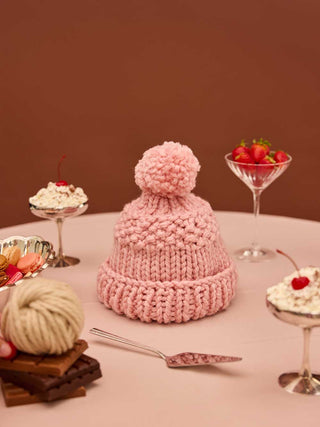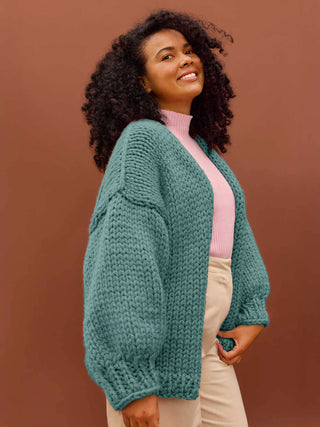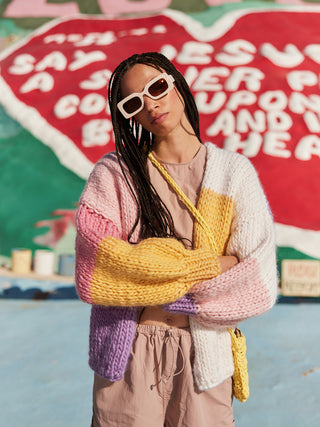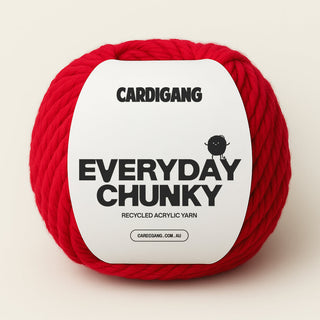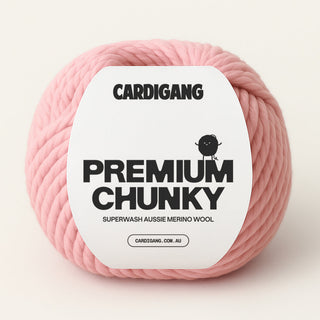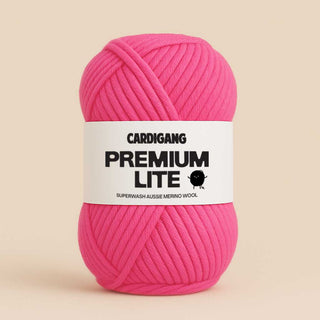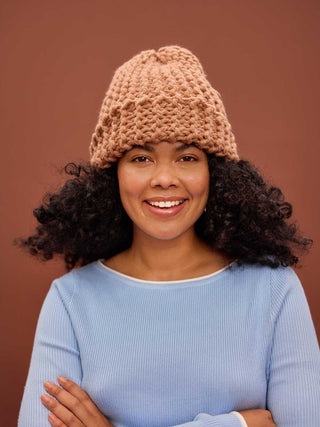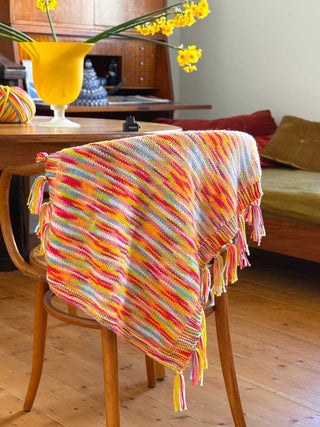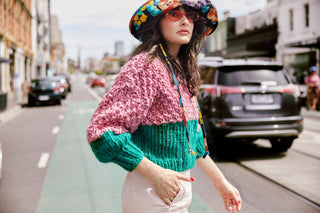A step by step guide to knitting the stunning Kristy Jumper.
Ever gotten half way through a project and thought “Hang on, am I even doing this right?”
We have 🙋♀️
That’s why we’ve created these step by step guides to walk you through the knitting process.
THE BASICS
If you're a total knitting newbie - WELCOME! 👋 Learning to knit can feel a bit like learning code. We've stripped away the complicated jargon and tried to keep things really simple so even the newest knitter can master the skill 🧶
Before we get started on the pattern it’s a good idea to learn the basic stitches you’ll need to complete your masterpiece. You can use the yarn that came in your kit to practice with. The video below covers every technique you'll need to learn (spoiler - there's only 5!). Learn how to cast on, do a knit stitch, a purl stitch and put them together to create a rib stitch, lastly, we learn casting off. Once you've got these mastered you'll find this pattern is a cinch!
💭 For more detailed videos of each technique, head down a little further where we've got specific videos for each stitch type.
YOU'VE GOT THIS ⚡️💪
Remember learning a new skill can be a little challenging at first, and you’re bound to find yourself making some mistakes along the way. But as with learning anything, your brain and your hands slowly start to get the hang of it, muscle memory is created, and soon the thing you found tricky/daunting/scary is like second nature!
If you get stuck, reach out to us and we'll give you a (virtual) hand! 😎
TEST YOUR TENSION
Before you start your project, you should make sure your tension (how tightly or loosely your knitting is) is juuuust right 🥣 We do this by knitting a “tension swatch”. It's a bit like goldilocks, if the tension is too tight, your piece will be too small, and if it's too loose it may not hold its shape and might be too big.
If done correctly, your 10x10cm knitted swatch should be 7 stitches wide and 9 rows high. To test this, jump on your needles, cast on around 12 stitches, then knit in stockinette stitch (row 1 knit, row 2 purl) for around 10 rows. Then get a measuring tape and measure out 10x10cm and count your stitches and rows to make sure you're knitting at the correct tension.
WHAT YOU’LL NEED
Your kit comes with everything you need to knit your masterpiece.
- 10mm circular needles
- 15mm straight needles
- Chunky Merino yarn in two colours
- Darning needle
THE TECHNIQUES YOU’LL MASTER
CASTING ON
Casting on is the first step in any project. It's the term we use for getting the wool onto our needles! We recommend using the two-needle technique as it's one of the simplest methods. Two-needle cast on uses your two needles (surprise!), starting with a slip knot on your left needle, each stitch is knitted to form a new loop and this loop is then added to your left needle. You repeat until you’ve made the desired number of stitches.
💭 Casting on, like many things in knitting, can be done in a number of ways - our suggestion is a simple technique but you can pick any that’s right for you.
KNIT STITCH
This handy little stitch makes up the backbone of most knitting patterns. Each knit stitch looks like a little ‘v’.
PURL STITCH
The second most common stitch, purl stitches look like little bumps (or purls!). You knit a knit stitch with your yarn tail at the back of your work and your needle going into the back of the stitch, the purl is the opposite, so your yarn tail is at the front of your work and your needle goes into the front of the stitch.
RIB STITCH
A rib stitch is a textured pattern usually used on the cuffs and necks of jumpers. It’s made by alternating knit and purl stitches in the same row, then knitting the same stitch sequence in the next row.
IRISH MOSS STITCH
This stitch is created over four rows by alternating between knit one and purl one, then purl one and knit one. For example, you knit one purl one for the entire row, like you did for the ribbing, repeating that row, then knitting the opposite stitches (purl one, knit one) in the next row and repeating that row. So while it might sound complicated, if you just think about repeating those four rows, you'll see the stitch emerge.
REDUCING STITCHES
We reduce the number of stitches on our needle by knitting or purling some stitches together. This simply means we put our right needle into the second stitch on your left needle and collect both the first and second stitch and knit them as you would a single stitch.
CASTING OFF
To cast off, knit two stitches then slip the first stitch on your right needle back over the second stitch and off the needle. You’ll have one stitch left on your right needle. Knit another stitch so you’ve got two stitches on your right needle and then slip the first stitch off. Continue to the end of the row. When you’ve got the last stitch on your right needle, cut the yarn and thread this through the final stitch to secure. To see casting off in action watch our "Master The Basics" video above.
CHANGING YOUR YARN BALLS
You'll need to change your wool balls at points in the process - when you finish one ball and starting another. If you’re just starting a new ball of the same colour then the best method for beginners is when you've got about 20cm of wool left on your current ball, you incorporate the tail from the new ball into your next stitch. You do this by starting your next stitch with your new tail and knitting on with that new ball, making sure the loose ends for both balls are on the wrong side/inside of your knit. Then all you need to do is tie the two ends together in a knot.
OKAY, LET’S KNIT UP A STORM!
THE KRISTY JUMPER
Kristy is one stylish gal who loves to get noticed. She's a boxy-cropped shape with a detailed Irish Moss stitch that's bit more special than your average stitch.
ONTO THE KNIT!
You can knit the Kristy in 1 (6-8), 2 (10-12) or 3 (14-16). Each piece of the cardi is knitted flat, at the end we'll stitch each panel together to make your cozy masterpiece. Your pattern is read like this: 1 (2, 3).
BACK
Okay guys, so we start with the back panel, it’s the simplest piece of the knit and will give you the confidence as you move onto other pieces.
We knit from the bottom up, stating at the rib and going up to the shoulders.
First, we cast the required number of stitches using your 10mm circular needles.
Once you've cast on the right number of stitches you move on to the rib. We knit the rib following the instructions in your pattern.
Once we've finished the allocated amount of rows, we switch to the 15mm straight needles.
💡 To switch to a different size needle we just hold the new needle in our right hand and knit onto it.
Once all stitches are on your right needle you turn your work over and continue to knit with the second 15mm needle.
You'll work the allocated rows of stockinette stitch.
Now, Kristy rocks an Irish Moss stitch which is a little more special than your average stitch. You'll change to colour 2 and start to knit your Irish Moss stitch.
When you've finished the last row of Irish Moss stitch on the back panel you cast off your stitches.
FRONT
The front is knitted up in the same way as the back, starting at the rib and working up through stockinette and Irish Moss stitches.
The neckline is where it gets a little tricky, but it's nothing you can't master!
To create the neck hole we split the panel into its shoulder sides and cast off a bunch of stitches in the middle. You'll knit the right shoulder up first and then tackle the gap for the neck and the left shoulder.
This video shows you how to create the neckline. Just remember to follow your pattern so you continue the Irish Moss stitch as we work up the neckline.
ARMS
Okay, onto the arms! You'll need two of these too! 😊
Now for these we start from the top of the arm and work down. We knit this piece flat just like the front and back.
You'll start with the allocated rows of Irish Moss stitch for the first section of the sleeve, then switch colours and do rows of Stockinette stitch.
To get that statement balloon sleeve we decrease the width of the sleeve by knitting two stitches together. It's really easy, you just pick up 2 stitches with your right needle instead of the normal one, and then knit the stitches as you normally would.
Once that’s done you swap to the 10cm needles and start your rib stitch.
💡 When you cast off make sure it’s not too tight otherwise you’ll have a really tight wrist hole.
SEWING IT TOGETHER
Now it’s time to get to work with the darning needle to sew your masterpiece together. We lay our pieces flat and sew them together one by one.
Step 1: lay your front and back pieces on a flat surface, the right sides facing you.
Step 2: Sew the shoulder panels together using the invisible seam technique, and leaving the hole for your head.
Step 3: Time to attach the sleeves to the body. Make sure the middle of your sleeve is lined up with the shoulder seam. This will ensure the seam of your sleeve is right under your armpit, not half way around your arm! Once you've made sure it's all lined up, sew the sleeves to the shoulders.
Step 4: Fold your jumper in half so it looks like the shape of a T. With the wrong sides facing each other, we're going to sew it together using a Mattress Stitch, from the cuff all the way up the arm to the arm pit, then down the side seam to the bottom of your jumper. And then repeat this on the other side.
💡 We suggest trying to match the colour yarn you use to the jumper to keep it as invisible as possible. It's normal for the wool to get a bit shabby as you go, so we recommend using a few pieces and tying them together underneath as you go!
THE NECK
Okay guys almost done!!! The last part is the neck. We knit the neck ‘in the round’. This means we use the circular needles instead of knitting back and forth on a row.
The neck is kitted in 1x1 rib stitch - you’ll be pretty good at this now!
So first things first. We pick up 34 stitches in equal distance from around the neck hole. There are a few different ways to do this but we’ve included a video of our fav technique below. Once you’ve got all your stitches on your needles you join the loop together and start the rib stitch. It’s a good idea to loop a hair tie or spare piece of yarn over your needle when you start so you can keep track of each loop.
Knit in the round until you’ve completed 4 loops then cast off.
💡 Now this part is critical! Cast of extra loosely!! You need a loose cast off in order to be able to fit your head through the hole. Rib stitch has a stretch to it, but if you cast off too tightly you'll have a hole that's too small for your head to fit through. Been there, done that and DON'T recommend 😝
The last thing we do for every piece is weave in the ends. That’s basically just tidying up the piece so all loose ends are trimmed down and tucked in.
FINITO! You are done! 💪🔥🥳
Time to rock that baby out and about 😎
We'd LOVE to see how you go! Share your masterpiece with us by tagging @cardigang_knits on socials or by sending us an email at hello@cardigang.com.au
Until next time! 😘🧶💕
Morgan & Cat xx


